GoWin R86S-N Internal Hardware Overview
Opening the bottom cover, the rubber feet stay attached, which is a nice touch. Inside, we can see a M.2 SSD slot and the top of our NIC. We ended up installing a M.2 SSD here because many OSes do not like being installed to eMMC media.
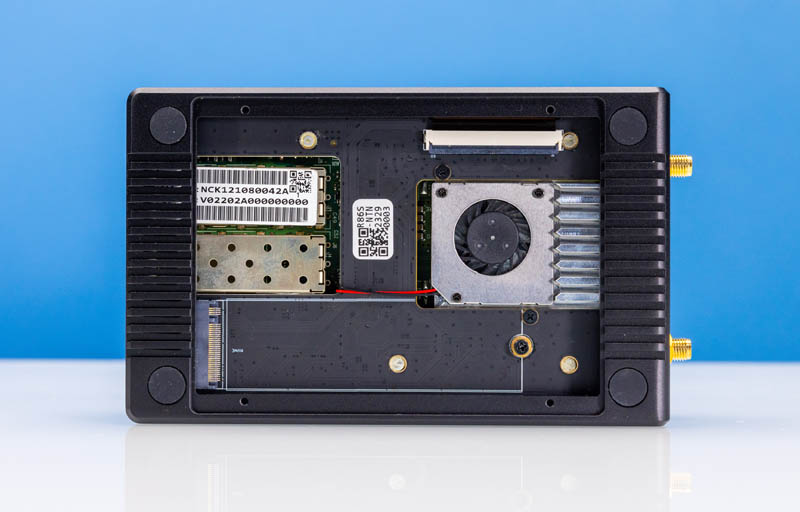
Opening this part of the shell, one can see the top of the Mellanox / NVIDIA ConnectX-4 Lx 25GbE SFP28 adapter. Between these two images, one can see that GoWin seems to have a custom fan on an OCP NIC 2.0 module.
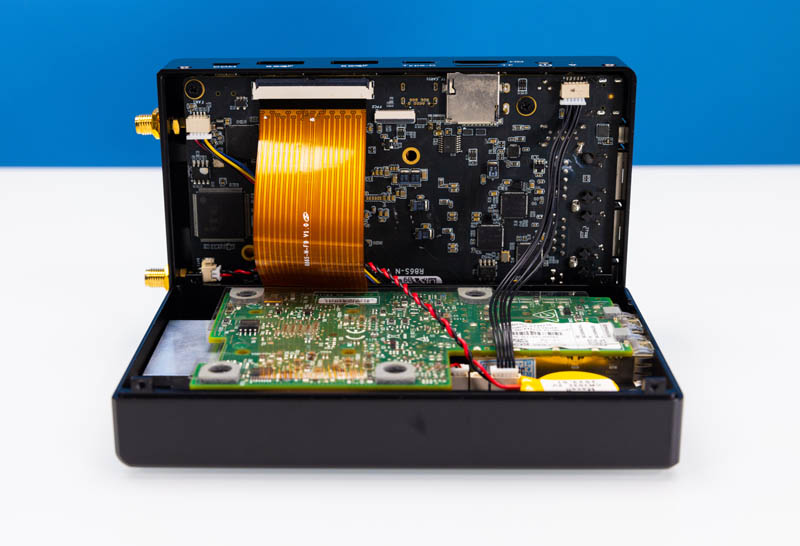
The ConnectX-4 Lx NIC is a very high-quality device that is supported in most OSes. Again, this is a difference since shipping versions will have SFP+. At the same time, one can look at this perhaps as a prototype for the rackmount version that will have 25GbE.
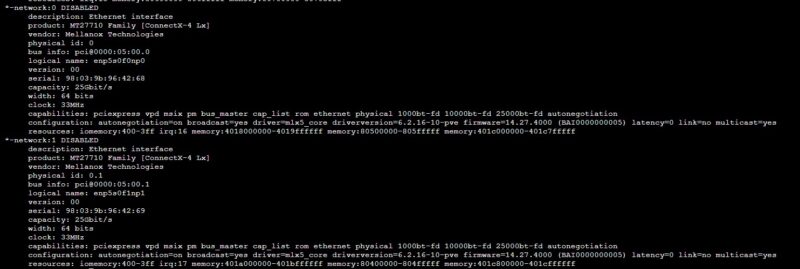
On the other side of the clamshell, we can see the other NICs. The sticker on the motherboard tells us we have not just a R86S-N but that this has an Intel Core i3-N305 processor, 32GB of memory, and a 128GB eMMC onboard. We can see on the left side the cluster of three Intel i226-V NICs (Intel SRKTU.)
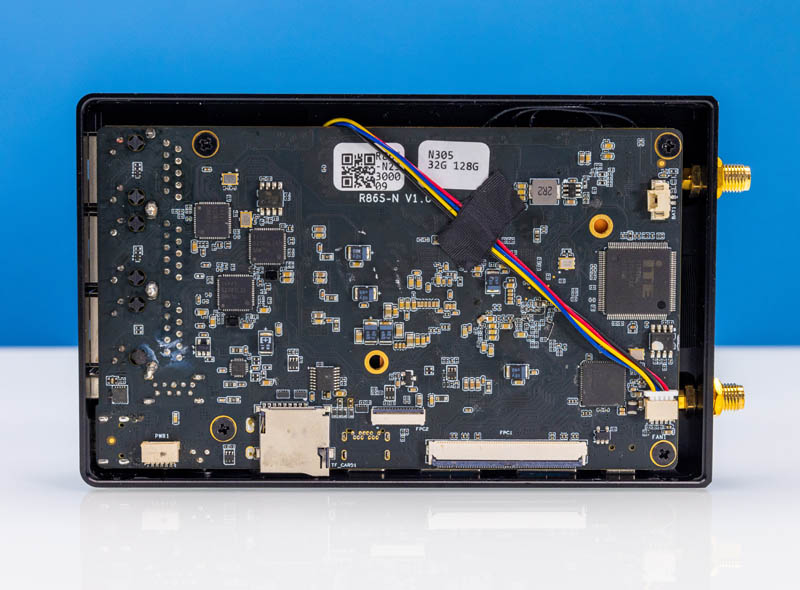
Here is what those look like in the OS, along with the onboard WiFi, which we will show later in this section.

With modern Linux OSes like Ubuntu and Proxmox VE, and now not just OPNsense but also pfSense, these NICs work out of the box.
While we have focused on the 25GbE/ 10GbE OCP NIC 2.0 bottom of this system, there is another option that shortens the height of the system and adds different slots.
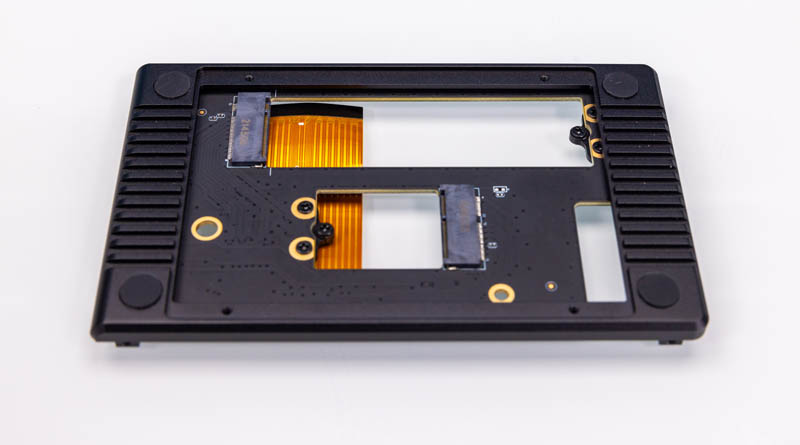
Here, we have a dual M.2 NVMe SSD setup along with a slot that we did not get to test, but that looks like another WiFi slot. Frankly, if you do not need 10GbE, it would be better to get this option for the bottom of the chassis.
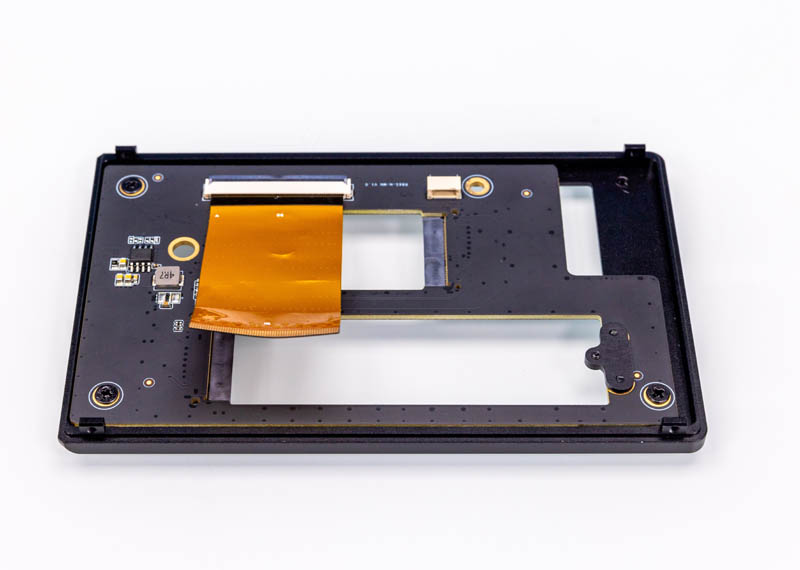
Taking the lid off the motherboard, we can see that we have a unit that had some special attention. The top of the case has the fan we saw in our external overview and the second we have seen inside now. The CPU was smothered in thermal paste. Let us just call it what it is; this is likely too much paste. We have a special 25GbE system, so more was likely added after that rework. This is much more than we saw on the CPU and copper plate of the original R86S.
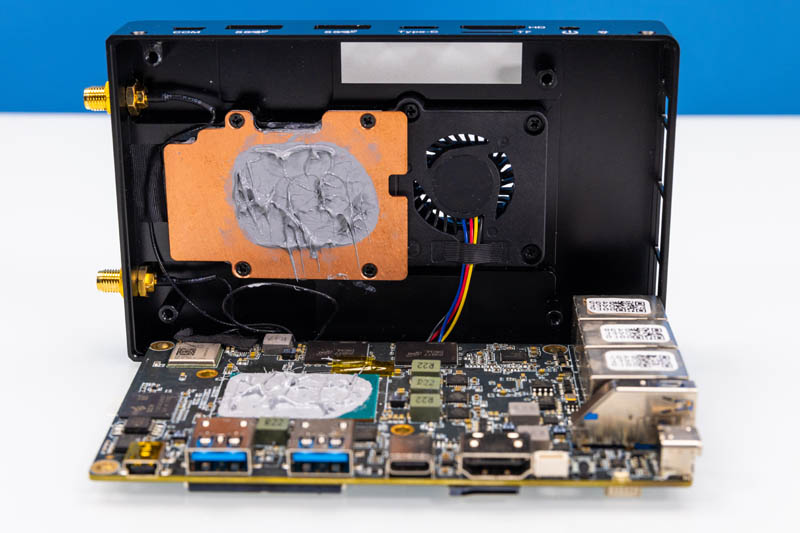
In the top corner of the motherboard, we have an Intel WiFi soldered solution. There are two Micron DRAM packages for 32GB also soldered. Likewise, the Intel Core i3-N305 is soldered. That means you need to pick the CPU and memory as part of the exact SKU ordered. On the other hand, we get eight cores, up from fuor. Each Alder Lake-N core is also faster. Having 32GB means we get 4GB/ core, and we do not need mitigations against Hyper-Threading side-channel attacks. We really like the N305 CPU because it is an enormous upgrade.
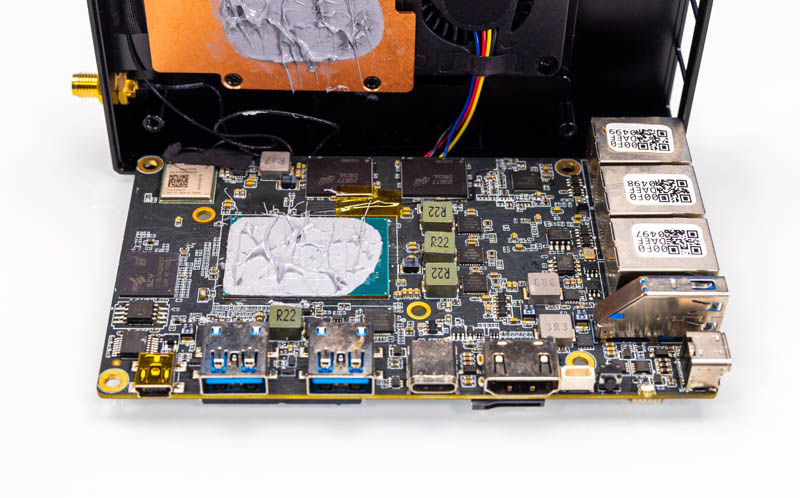
These systems also have onboard eMMC. We have the high-end 128GB of eMMC soldered so that is another ordering option.
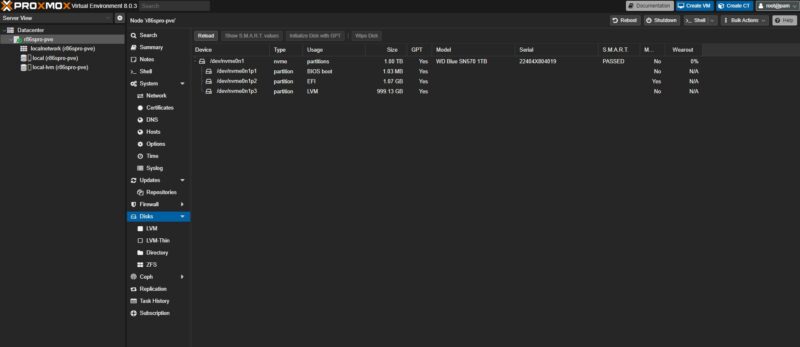
While OSes like OpenWRT will run happily on eMMC, many modern OSes do so much logging that they prefer not to be installed on eMMC. As a result, OSes like Proxmox VE either need a SSD installed, as we have here, or a workaround to get them installed on eMMC.
Next, let us get to the performance.




Can the 25gbe SFP+ ports negotiate and run at other speeds like 10gbe, 5gbe, 2.5gbe, or 1gbe?
Hot damn. These would be perfect here in Switzerland. Init7, a local ISP, will give you 25Gbps FTTH as a one-off upgrade, no change to monthly costs. The main obstacle is the cost of equipment to handle 25Gbps but these boxes look perfect.
It cannot fully exploit the 25 Gb interfaces and it is CPU-wise far inferior to most other options. I have to ask what is the point? Interfaces on the front _and_ the side. The layout is not optimal.
Once upon a time there was a Raspberry Pi with 1 Gbps Ethernet connected through USB 2. The resulting packet loss conspired with Internet latency and switches with no flow control for throughput that ended up below 100 Mbps.
In my opinion any system that can’t receive packets at wire speed (whatever that speed may be) is likely to experience similar problems.
@emerth Totally agree. These are being revered by STH and a small almost religious following for the cuteness factor alone. Fans that are non standard and CPU that are underpowered for the NIC interfaces and in small formfactor for the cuteness factor alone.
x86S team needs to rethink the design, it needs standard replacable fans as a minimum also larger footprint, but then it will look like any of the other 117 other options on the market, maybe the 10gig or 25gig interfaces being the only distinguishing attribute.
I would like to know if you could disable unneeded chips like sfp+ ports. they are definitely useful but I expect most would want this as future proofing but as most have 1gbit internet or slower right now, leaving those sfp+ chips idling would be chewing 5 watts. Similarly, many wont be using wifi chips so wont need it inbuilt.
Nigel – You can use the NVMe bottom and remove the NIC completely.
Lance – I guess my question is whether you have used the R86S original or the new N305 one reviewed here? As someone who has personally used over 117 different mini PCs/ 1L PCs in the last three years (there are ones we never reviewed as well) you are right my team and I like the R86S and this new version. We bought more R86S’s and we use them all the time.
It’s R86S-N305C
there’s a reference to a potential 1U, anymore info on that?
John – I think it is launching this month and we are getting one, the early sample has not arrived yet.
Any idea whether that short M.2 slot on the alternate bottom supports 2230 sized storage (like in the Steam Deck) vs. only wi-fi? I’d love to use that for the boot drive for proxmox/truenas and pass-through the other 3 m.2 slots I’d have in that configuration for a zfs pool.
Oh man, with the Mellanox Connect-4 Lx board this looks perfect for what I want it for. Only interested in 10 Gbps operation with the SFP28 ports.
They have the version with a CX-4 Lx up on AliExpress now, but at quite a premium.
I’m not really sure what the purpose of these devices are. Are they for network routing? If so how do you rackmount them when some of the sockets are on the side, or access the button on top? Perhaps they are only meant to sit singly on a desk? If so, it will look a bit messy with all the cables sticking out in every direction. Are they meant for outdoor use with WiFi links? If so do they have suitable outdoor enclosures?
Compare this to say MikroTik, who have router designed products that can be stacked in a 2×2 configuration and rack mounted in a 1U space, with all sockets accessible on the front and back. They have outdoor products too that ship already in waterproof enclosures. They also have products aimed for desktop use with all the sockets on the back so that cables neatly flow down behind a desk reducing clutter.
It’s clear to me where each MikroTik product is targeted, but with something like this I’m not really sure what they are targeting, and the design seems to have too many compromises to make it practical in any particular environment.
It seems like the only use case is for the ultra budget conscious where practicality and tidiness take a back seat to cost. But then someone in that position seems unlikely to spring for 25 GbE gear so the Raspberry Pi seems more suitable for that market segment.
Unfortunately it is not in stock.
I am trying to recommend some systems for few friends that need small 25G router with few 2.5G ports and WiFi, and this is absolutely perfect in form factor and functionality. In fact there is nothing else like this.
(At home I have a bigger custom 25G router in 2U case; but some of my friends and clients, want something smaller and less ports)
The issue is probably that at full 25G it will be bottlenecked by CPU and thermals, so I understand it is not perfect. I am still searching for something small, and capable of 25G routing (IPv4, IPv6, with IPv4 NAT and few very simple port forwardings, not much more, probably running VyOS, or similar).
PS. servethehome rejects plus sign in my email address, despite it being totally valid address.
In a review (on STH or LevelOneTechs) of the earlier R86S, there was a hint that they were working on a model that would work in WiFi Access Point mode, instead of only Client mode. I don’t see anything about Access Point mode in this R86S-N model review. So, I’m wondering if there’s any additional info about the “Access Point” model (name / PN / availability)?
It’s a nice concept. It feels great in the hand and looks the part. But watch out if you need any form of support or if something goes wrong. I purchased two of the N305 models. There are some significant design and manufacturing failures from damaged internal ribbon cables, bad thermal connection, to non-op/dead wifi. The worst part is the total absence of meaningful support. Their single customer facing rep, David, promises action and follow-up but then does neither. Always claims to be traveling. I can’t even get them to provide an address to return things. Zero response.